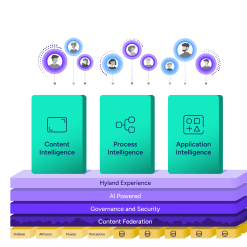Hyland’s approach to progress: Customer-centricity
We know that every decision we make has the potential to impact thousands of organizations and millions of Hyland users. That isn’t a responsibility we take lightly.

Harness the power of a unified content, process and application intelligence platform to unlock the value of enterprise content.
Learn more
Explore Hyland’s solutions by industry, department or the service you need.
Overview of solutionsIt's your unique digital evolution … but you don't have to face it alone. We understand the landscape of your industry and the unique needs of the people you serve.
 Overview of industries
Overview of industries
Countless teams and departments have transformed the way they work in accounting, HR, legal and more with Hyland solutions.
 Overview of departments
Overview of departments
We are committed to helping you maximize your technology investment so you can best serve your customers.
 Overview of services
Overview of services

Discover why Hyland is trusted by thousands of organizations worldwide.
Hear from our customers
Our exclusive partner programs combine our strengths with yours to create better experiences through content services.
Overview of partners
Find resources to power your organization's digital transformation.
Browse the resource center
Hyland connects your content and systems so you can forge stronger connections with the people who matter most.
Learn about HylandWith our modern, open and cloud-native platforms, you can build strong connections and keep evolving.
 Dig deeper
Dig deeper
August 27, 2024
Reading time minutes
We know that every decision we make has the potential to impact thousands of organizations and millions of Hyland users. That isn’t a responsibility we take lightly.

Hyland's team

At Hyland, we’re committed to being all about our customers. We always have been. In good times and bad, our commitment to our customers remains our North Star.
No matter the state of the market or how quickly business changes, Hyland prioritizes intelligent, user-driven, continuous improvements, made at the pace of our customers’ progress. We help them meet real-world business demands.
We know our real power extends far beyond the initial deal. Partnering with us isn’t just about the buying experience or purchase decision; it’s about the experience of being a long-term Hyland customer.
Hyland remains committed to developing innovative, advanced technologies. And we are even more committed to our belief that technology is only part of the equation. The other part — the bigger, more important part, if you ask us — is the people who use that technology.
Over the past few years, our customers have been asked to address a slew of new business challenges, like:
But they also had to continue to find modernized solutions to their more familiar challenges as well. These include initiatives like:
We support our customers as they face both sets of challenges. Often, we find it’s the second set — the behind-the-scenes improvements to business-critical processes — that ultimately empowers people and improves experiences.
We know those familiar challenges will endure no matter what the market throws our way. We also know there’s risk in trying to move too far, too fast. If we get too far ahead of the organizations that are looking to optimize their existing processes before tackling new ones, our visions may become misaligned.
We remain customer-focused above all else, with a strong commitment to meet our customers where they are.
Customers evaluate us regularly based on their everyday experiences with our platforms: How easily our software installs, how well it works, how well we support it and, ultimately, how well we support their business goals.
Our customer commitment inspires us to maintain our unwavering focus on our customers — from initial meeting to planning for long-term success. While this may sound simple, in practice, it is anything but. It takes determination, prioritization and know-how that most other vendors can’t match.
And that’s where we shine.
Of course, technology experts also have opinions. Analysts provide valuable insight into our industry, and we recognize how important it is for people considering Hyland to have objective third-party commentary on what we’re doing.
In recent months, Hyland has been named:
This recognition guides us as we continue to deliver the solutions and capabilities our customers need today and will need for years to come.
Hyland will continue to focus on what our customers need today, even as we continue developing and maintaining the modern, innovative technology they will need in the future.
Here’s how we’re maintaining stability, supporting growth and preparing for a customer-focused future:
We make most of our solution enhancements based on user feedback, an approach that ensures we’re aligned with the real needs of the market. Our user-focused capabilities and customer-driven innovation have resulted in solutions and features that deliver tangible, measurable value.
We have 30-plus years of proven success delivering secure, flexible content and process solutions, and we’re trusted by more than half of Fortune 500 companies and two-thirds of Fortune 100 companies.
We pride ourselves on helping customers achieve sustainable success in healthcare, government, education, financial services and more. By hiring experts who have gained a deep understanding of these industries working in the fields themselves, we gain unique insights into the markets as they evolve. We also recognize the importance of open integration with the core line of business applications that are crucial to our core industries, and we prioritize product enhancements that make these connections more seamless.
We continue to expand and evolve our technical support and professional services offerings, to better support our customers throughout every stage of their modernization journeys.
Hyland will continue to lead the way with user-friendly, agile, integrative solutions that empower people to deliver their best in a constantly changing world.
We will continue to expand intelligent automation capabilities across our platform, with specific investment in process automation, artificial intelligence and machine learning, in anticipation of automation’s increasing importance in the market. Plus, helping you make your content AI-ready is an important part of our commitment to you.
Hyland aims to continue leading the way in innovative content and process capabilities. We know how critical it is for our customers to be able to serve their customers (whether that’s constituents, students, patients or employees) with the right technology. As with any journey, there will be times where we cover a lot of ground quickly, and times where we pause to prepare everyone (including our customers) for the next big thing. But there will never be a time where we give up or lose focus.
Thank you to our customers for taking this journey with us and transparently providing ongoing feedback. We wouldn’t be where we are — or get where we’re going — without you.